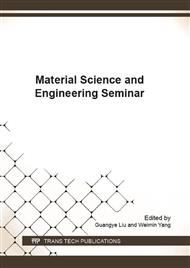[1]
ZHANG Yuxia, LIU Xue, LIU Bengang, et al. Foaming Progress biodegradable polymers. Chinese Plastic, 2012, 26(4), 4-15.
Google Scholar
[2]
LEI Yanxiang. The present situation and development prospect of PLA technology and market. Petroleum &Petrochemical, 2007, 15(1), 39-43.
Google Scholar
[3]
Drum right R E, Gruber P R, Henton D E. Polylactic acid technology. Advanced Materials, 2000, 12(23), 1841-1846.
DOI: 10.1002/1521-4095(200012)12:23<1841::aid-adma1841>3.0.co;2-e
Google Scholar
[4]
Lim LT, Auras R, Rubino M. Processing technologies for poly (lactic acid). Prog Polym Sci, 2008, 33(8), 20-52.
Google Scholar
[5]
Di Y, Iannace S, Di Maio E, Nicolais L. Reactively modified poly(lactic acid): properties and foam processing. Macromol Mater Eng, 2005, 290(11), 1083–1090.
DOI: 10.1002/mame.200500115
Google Scholar
[6]
Li G, Li H, Turng LS, Gong S, Zhang C. Measurement of gas solubility and diffusivity in polylactide. Fluid Phase Equilib, 2006, 246(1-2), 158-166.
DOI: 10.1016/j.fluid.2006.05.030
Google Scholar
[7]
Mahmood SH, Keshtkar M, Park CB. Determination of carbon dioxide solubility in PLA with accurate PVT properties. J Chem Thermodyn, 2013, 70, 13-23.
DOI: 10.1016/j.jct.2013.10.019
Google Scholar
[8]
Takada M, Hasegawa S, Ohshima M. Crystallization kinetics of poly(l-lactide) in contact with pressurized CO2. Polym Eng Sci, 2004, 44(1), 186-196.
DOI: 10.1002/pen.20017
Google Scholar
[9]
Nofar M, Zhu W, Park CB. Effect of dissolved CO2 on the crystallization behavior of linear and branched PLA. Polymer, 2012, 53, 3341-3353.
DOI: 10.1016/j.polymer.2012.04.054
Google Scholar
[10]
Taki K, Kitano D, Ohshima M. Effect of growing crystalline phase on bubble nucleation in poly( l-lactide)/CO2 batch foaming. Ind Eng Chem Res, 2011, 50(6), 3247–52.
DOI: 10.1021/ie101637f
Google Scholar
[11]
Corre YM, Maazouz A, Duchet J, Reignier J. Batch foaming of chain extended PLA with supercritical CO2: influence of the rheological properties and the process parameters on the cellular structure. J Supercrit Fluids, 2011, 58(1), 177-188.
DOI: 10.1016/j.supflu.2011.03.006
Google Scholar
[12]
S Pilla, A Kramschuster, S Gong, A Chandra L-T, Solid and microcellular PLA-carbon nanotube nanocomposites. Intern Polymer Processing, 2007, 22(5), 418-428.
DOI: 10.3139/217.2071
Google Scholar
[13]
DI Y W, Iannace S, DI M E, et al. Poly(lactic acid)/organoclay nanocomposites: Thermal, rheological properties and foam processing. Journal of Polymer Science Part B-Polymer Physics, 2005, 43(6), 689-698.
DOI: 10.1002/polb.20366
Google Scholar
[14]
LU Xiuling. Preparatioa and High-Pressure Vessel Faaming of Poly(lactic acid)/ Acetylated Starch Blends and Their Nanocompasites. Guangzhou, South China University of Technology, (2012).
Google Scholar
[15]
YUAN Hua, ZHAO Qiufeng, LIU Zhiyong. Research on the composite foam (I) of PLA/Starch Composites: A Study on the foaming process. FRP / Composites, 2009, 1, 42-46.
Google Scholar
[16]
Andrew Chow, Esther Richards, Reza Rizvi et al. Biodegradable Composite Foams of PLA and PHBV Using subcritical CO2. J Polym Environ, 2008, 16, 258-266.
DOI: 10.1007/s10924-008-0110-y
Google Scholar
[17]
Hwang SS, Hsu PP, Yeh JM, Chang KC, Lai YZ. The mechanical/thermal properties of microcellular injection-molded Poly(lactic acid) nanocomposites. Polymer Composites, 2009, 30(11), 1625-1630.
DOI: 10.1002/pc.20736
Google Scholar
[18]
Adam Kramschuster, Lih-Sheng Turng. An Injection Molding Process for Manufact- -uring Highly Porous and Interconnected Biodegradable Polymer Matrices for Use as Tissue Engineering Scaffolds. Journal of Biomedical Materials Research Part B: Applied Biomaterials, 2009, 10(2), 366-376.
DOI: 10.1002/jbm.b.31523
Google Scholar
[19]
Ray SS, Okamoto M. New Poly(lactic acid)/layered silicate nanocomposites. Macromol Mater Eng, 2003, 288(12), 936-944.
DOI: 10.1002/mame.200300156
Google Scholar
[20]
JIANG Shanshan. Research On the preparation and foaming process of PLA/OMMT nano- -composites. Guangzhou: South China University of Technology, (2011).
Google Scholar
[21]
Srikanth Pilla, Seong G. Kim, et al. Microcellular extrusion foaming of PLA/poly (butylenes adipate-co-terephthalate) blends. Materials Science and Engineering, 2010, 30(4), 255-262.
DOI: 10.1016/j.msec.2009.10.010
Google Scholar


